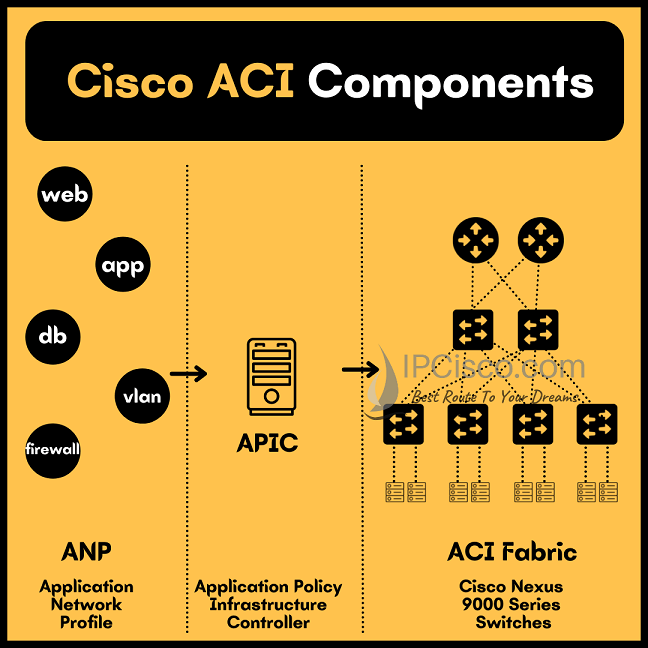- COURSES
- SPECIALS
- BLOG
- MEMBERS
- SHOP
- ABOUT
- ENROLL HERE

Cisco ACI is an important solution with Software Defined Networking (SDN) In this lesson, we will talk about detailly with this SDN Solution. We will focus on What is Cisco ACI? Why we use it? We will learn what are the Architecture Components of Cisco ACI one by one. So, let’s start.
Table of Contents
Cisco ACI (Application Centric Infrastructure) is an SDN Solution (Software Defined Networking Solution) that allow to manage complex networks with network automation. Normally, in traditional networks, we configure the network devices and they do what we have configured. This is an imperative system control method. But with Cisco Application Centric Infrastructure, we say what we want as a result from the system and the devices interpret this to themselves and give us what we want. This technique is declarative system control method.
Cisco Application Centric Infrastructure is a Cisco solution. With this solution, Cisco has brought an advanced and innovative approach to SDN. With this new technology, this hardware solution has integrated cloud computing and data center management.
You can also check other Cisco CCNA Certification Lessons
Cisco Application Centric Infrastructure is a policy-driven SDN solution which integrates hardware and software. As hardware, Cisco Nexus 9000 Series Family is used. As software, Data Center Pod, Data Center Policy Engine are used. Beside there are also non-directly attached virtual and physical leaf switches are used in this architecture. So, what are the components of this ACI structure? What is the Cisco ACI Architecture Components? Let’s learn each of them one by one.
There are mainly three components of Cisco ACI Architecture. These are given below:

ANP (Application Network Profile) is the collection of end point groups with their policies and connections. These end point groups can be web services, applications, vlans etc.
APIC (Application Policy Infrastructure Controller) is the central management part of Cisco ACI Architecture. The management and operation of ACI cluster fabric is done here. APIC translated policies into network programming.
APIC (Application Policy Infrastructure Controller) resides between ANP (Application Network Profile) and ACI enabled network infrastructure. The main role of APIC is translating the application requirements into network configurations. By doing this expected network behavior is done.
With APIC, operational model has changed. It got only what to do instead configurations. In other words, network engineers do not need to connect each switch and configure it as they did before. Instead, they use cloud software, virtualization software or automation software to say what to do. And this declaration reaches to Cisco Application Centric Infrastructure Fabric over APIC.
Cisco Nexus 9000 Series Switches are the switches which are used with Cisco Application Centric Infrastructure. These switches work with ACI to manage the physical and the virtual network infrastructure. Cisco ACI Fabric uses spine and leaf architecture.
In Cisco ACI Fabric there are Leaves and Spines. The leaves are connected to spines as full mesh but they do not connect each other. Again, Spines connect to core switches and leaves and they do not connect each other. And lastly, endpoints can only connect to leaves. This is spine and leaf architecture of Cisco Application Centric Infrastructure Fabric. Here, the leaves can be Cisco Nexus 9300 Series and the spines are Cisco Nexus 9500 Series switches.
In this architecture, there are also endpoints. And the endpoints can be any device. It can be a remote router, a server or a virtual switch.
Leave a Reply